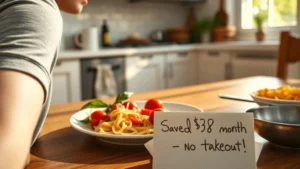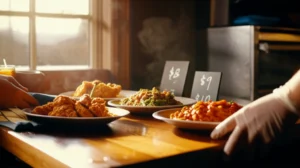Okay, let me start with something I bet you know all too well: you think you’ve got your spending on eating out under control… until you check your bank app. And, bam! There it is—another $80 dinner that you totally didn’t plan for. Happens to the best of us. But what if I told you that setting a realistic budget for eating out doesn’t have to feel like a punishment or a puzzle? It can actually be the key to enjoying your meals more and worrying less about money. Crazy, right?
So instead of launching into dry definitions, let’s kick it off like friends chatting over a cup of coffee (which, yes, you could make at home). I’m going to walk you through how to find your own practical eating-out budget, sprinkled with real numbers, stories, and some neat examples. Ready? Let’s dive in.
Why Costs Balloon
Have you ever noticed how that latte here, quick lunch there, and occasional dinner out add up faster than you realize? Eating out is sneaky. It feels little, but when those expenses stack week after week, suddenly your “fun money” disappears.
How Often Are You Really Eating Out?
Stop for a sec and think: how often do you hit the drive-thru, grab lunch with co-workers, or say “yes” to dinner plans? For some, it’s more than a few times a week. For others, rare treat territory.
Knowing your frequency is the first step. I remember a friend budgeting $300 a month as a single person, thinking it was plenty — then realizing with surprise that two fancy dinners at $60 each already ate most of it. Average meals can hit $15–$50 depending on time and place, so the occasional night out really stacks up.
What’s a Typical Meal Cost?
Here’s a quick breakdown to give you a reality check:
- Breakfast: $10 to $25 (think coffee and pastry vs. full diner plate)
- Lunch: $15 to $30 (sandwich and soda or salad and juice)
- Dinner: $17 to $50 or more (casual vs. nice sit-down)
And don’t forget tips and taxes sneak in, pushing those numbers up a bit.
City vs. Suburbs
Prices also vary a ton depending where you live—big cities tend to be pricier. A $40 dinner in NYC might only be $25 somewhere else. So your “realistic budget” is going to be impacted by this too.
Common Spending Averages
Okay, let’s sprinkle in some numbers from real research and examples to build a clearer picture.
What Do Most People Spend?
Americans tend to spend around $300 each month eating out. But it depends a lot on household size:
| Household | Average Monthly Spend |
|---|---|
| Single person | $222 |
| Couple (no kids) | $373 |
| Family of 3 | About $400–450 |
| Family of 4 | $500 |
These figures help set a baseline. Honestly, what feels realistic for you might fall somewhere around here—or maybe even outside it. You can peek at this Average eating out cost per month for 1 person and also this Average eating out cost per month for 2 to get a better idea about your situation.
So, What Really Shapes Your Budget?
A lot! Your income, where you live, your social habits, family size, and even your goals. Are you saving for a trip? Paying off debt? Wanting to build an emergency fund? All those play a role.
The 10-15% Rule
Some financial pros say: Keep dining out within 10–15% of your monthly income (usually combined with entertainment). So if you make $3,000 after tax, maybe $300-$450 can be your max—not just for eating out, but everything fun.
If you want to stretch your dollars a bit, tracking your real spending first is key. And be gentle with yourself if you’re not a budgeting wizard just yet. I remember someone on Reddit who blew their $300 budget monthly but then adjusted it after realizing weekends with guests caused the spike. They started pulling extra from their entertainment fund during busy weeks and felt less stressed. Makes sense?
How to Find Your Number
Track Your Current Spending
Start simple: jot down everything you spend on eating out for a month—yes, every coffee, snack, and meal. Use that data to see where you land.
Is your budget fair? Or way off? Did you budget $150 and spend $400? Time to tweak either what you eat out or your budget.
Think About the Why
Are you craving quick meals because you’re too tired to cook? Or is dining out your main social outlet? Understanding these cravings helps shape a plan that really suits you. Sometimes it’s less about cutting back and more about swapping choices.
Lunch vs. Dinner
Try switching dinner outings to lunch ones—they tend to be cheaper and often just as tasty. It’s a neat trick for keeping your restaurant indulgences while saving cash.
Making Your Budget Work
Create Flexibility
No shame in “borrowing” from your coffee or entertainment funds if you have a special event coming up—and recouping later. Budgets aren’t walls; they’re guides.
Example Breakdown
For a single person, a practical monthly plan could look like this, inspired by a Restaurant budget example I love:
- 2 dinners out, $40 each = $80
- 4 lunches at work, $10 each = $40
- Coffee/quick bites = $30
- Total: $150
For couples or families, try scaling and adjusting based on the Average eating out cost per month for 2 and Average eating out cost per month family of 4. It’s okay to start a bit lower and increase if you find room in your budget or lifestyle changes.
Simple Hacks To Stretch It
| Tip | Why It Works | Potential Savings |
|---|---|---|
| Choose Lunch Over Dinner | Smaller menus, lower prices | 30-50% less per meal |
| Take Leftovers Home | Eat twice for the price of one | $10-$20 per meal |
| Mix Home-Cooked Meals In | Reduce overall spend without giving up enjoyment | Halves weekly costs |
Ready to Take Control?
So, what is a realistic budget for eating out, really? It’s the one that fits your lifestyle, wallet, and goals without guilt or guesswork. The average numbers we’ve chatted about ($222 for singles, up to $500+ for families) give you a starting line. But yours will be your own finish line.
Track what you spend, figure your why, and then build a plan that feels like freedom, not restriction. And remember—budgets are a living thing. They change with your life, your income, and yes, even your mood. Some months you’ll splurge, some months you’ll scale back, and all of that counts.
Give it a try this month! Maybe start by tracking your eating out, then compare your spend to this Average eating out cost per month for 1 person. Play with the numbers and see what gives you that happy balance.
Got a budget you swear by? Or a fun way you save on restaurant meals? Share your story below—because we’re all figuring this out as we go.













